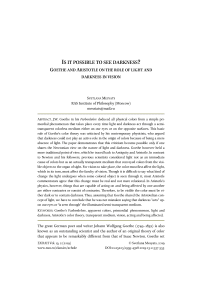Is it possible to see darkness? Goethe and Aristotle on the role of light and darkness in vision
Автор: Mesyats Svetlana
Журнал: Schole. Философское антиковедение и классическая традиция @classics-nsu-schole
Рубрика: Статьи
Статья в выпуске: 2 т.13, 2019 года.
Бесплатный доступ
J.W. Goethe in his Farbenlehre deduced all physical colors from a simple primordial phenomenon that takes place every time light and darkness act through a semi-transparent colorless medium either on our eyes or on the opposite surfaces. This basic rule of Goethe’s color theory was criticized by his contemporary physicists, who argued that darkness could not play an active role in the origin of colors because of being a mere absence of light. The paper demonstrates that this criticism became possible only if one shares the Newtonian view on the nature of light and darkness. Goethe however held a more traditional point of view, which he traced back to Antiquity and Aristotle. In contrast to Newton and his followers, previous scientists considered light not as an immediate cause of colors but as an actually transparent medium that conveyed colors from the visible objects to the organ of sight. For vision to take place, the color must first affect the light, which in its turn, must affect the faculty of vision. Though it is difficult to say what kind of change the light undergoes when some colored object is seen through it, most Aristotle commentators agree that this change must be real and not mere relational. In Aristotle’s physics, however, things that are capable of acting on and being affected by one another are either contraries or consist of contraries. Therefore, to be visible the color must be either dark or to contain darkness. Thus, assuming that Goethe shared the Aristotelian concept of light, we have to conclude that he was not mistaken saying that darkness "acts” upon our eyes or “is seen through” the illuminated semi-transparent medium.
Goethe's farbenlehre, apparent colors, primordial phenomenon, light and darkness, aristotle's color theory, transparent medium, vision, acting and being affected
Короткий адрес: https://sciup.org/147215828
IDR: 147215828 | DOI: 10.25205/1995-4328-2019-13-2-537-553
Список литературы Is it possible to see darkness? Goethe and Aristotle on the role of light and darkness in vision
- https://nsu.ru/classics/schole/13/13-2-mes.pdf
- Burnyeat, M. (1995) "How much happens when Aristotle sees red and hears middle C?" M.C. Nussbaum, A. Rorty, eds. Essays on Aristotle's "De Anima". Oxford: Clarendon Press, 421-434.
- Burnyeat, M. (2002) "De Anima II, 5", Phronesis XLVIII, 28-88.
- Eastlake, Ch. L., transl. (1840) Goethe’s Theory of colors. London: John Murray.
- Caston, V., transl. (2012) Alexander of Aphrodisias. On the Soul. Part I. London, New York: Bloomsbury.
- Guerlac, H. (1986) "Can there be colors in the Dark? Physical Color Theory before Newton", Journal of the History of Ideas, 3-20.
- Hett, W. S. transl. (1936) Aristotle. On the Soul, Parva naturalia, On Breath. London: Harvard University Press.
- Johansen, T. K. (1997) Aristotle on the sense-organs. Cambridge: Cambridge University Press.
- Matthaei, R., Hrsg. (1958) J.W. Goethe. Zur Farbenlehre. Historischer Teil, LA I, 5. Weimar: Hermann Bohlhaus Nachfolger.
- Ott, G. und Proskauer, H.O., hrsg. (1979) J.W Goethe. Farbenlehre. Mit Einleitungen und Kommentaren von Rudolf Steiner, Bd. I-III. Stuttgart: VFG.
- Proskauer, H. O. (1985) Zum Studium von Goethes Farbenlehre. Basel: Zbinden Verlag.
- Ribe, N. and Steinle, F. (2002) "Exploratory Experimentation: Goethe, Land and Color Theory", Physics today 55, 43-47.
- Ross, D., ed. (1955) Aristotle. Parva naturalia. Oxford: Clarendon Press.
- Ross, D., ed. (1961) Aristoteles. De anima. Oxford: University Press.
- Ross, D. (1995) Aristotle. London: Routledge.
- Sorabji, R. (1995) "Intentionality and Physiological Processes: Aristotle's theory of sense perception", M.C. Nussbaum, A. Rorty, eds. Essays on Aristotle's "De Anima". Oxford: Clarendon Press, 195-227.
- Sorabji, R. (2001) "Aristotle on Sensory Processes and Intentionality. A Replay to Myles Burnyeat", D. Perler, ed. Ancient and Medieval Theories of Intentionality. Leiden: Brill, 49-61.
- Steiner, R. (1979) "Goethe als Denker und Forscher", G. Ott and H. O. Proskauer, hrsg. J.W. Goethe. Farbenlehre. Mit Einleitungen und Kommentaren von Rudolf Steiner, Bd. I. Stuttgart: VFG.
- Towey, A., transl. (2000) Alexander of Aphrodisias. On Aristotle's "On Sense Peception". Ithaca, New-York: Cornell University Press.
- Turnbull, H. W., ed. (1959) Newton. Correspondence of Isaac Newton, v. I. Cambridge: Cambridge University Press.
- Wendland, P., ed. (1910) Alexandri Aphrodisiensis In Aristoteles De sensu commentaria, CAG, Bd. 3.1, Berlin: Reimer.
- Wenzel, M., Hrsg. (1991) J.W. Goethe. Schriften zur Farbenlehre 1790-1807, Bd. XXIII / 2. Frankfurt am Mein: DKV.
- Williams, C. J. F., transl. (1982) Aristotle’s De generatione et corruptione. Oxford: Clarendon Press.


